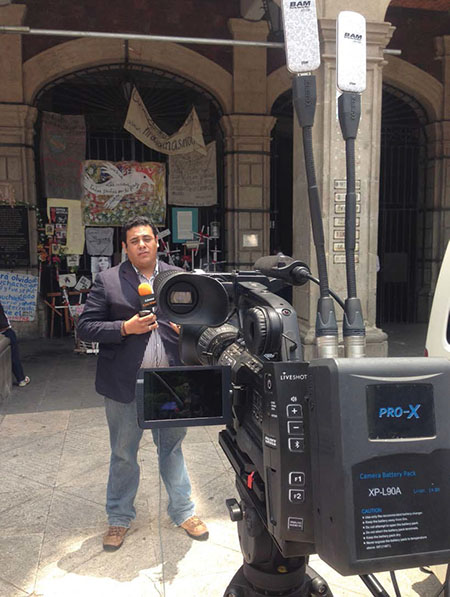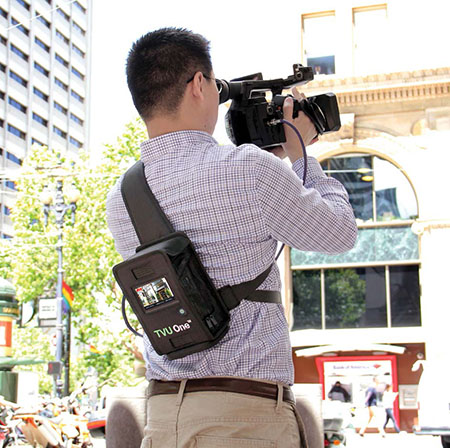HEVC Advances Enhance Cell-Based ENG
SEATTLE—Since its introduction a decade ago, cellular-based liveshot gear has been steadily improving at bringing high-quality live news video and audio back to the studio. Some of that can be attributed to better 4G (and someday 5G) cellular network technology, as well as the availability of more cell towers. Individual equipment makers have made their own tweaks that have improved performance.

Mundo TV Morelos uses Comrex’s LiveShot to cover a peace march in Cuernavacas, Mexico.
ENCODING EFFICIENCY
And then there’s new encoding technology showing its face—HEVC/H.265—which promises a doubling of encoding efficiency.
“With the same bandwidth, we can do twice the quality of everything,” said Jon Landman, vice president of sales for Teradek, an Irvine, Calif.-based provider of wireless video technology.
Matt McEwen, vice president of product management at TVU Networks adds that “doubling of encoding efficiency also makes it possible to get a higher quality picture out of low bandwidth areas.” And since cellular network time is a pay-as-you go, bit-by-bit arrangement, for any given quality of video delivered back to the station, HEVC encoding cuts the cellular network costs in half.
LiveU has introduced a new version of its backpack platform, the LU600 that is the same form-factor as the company’s traditional LU500, according to Claudia Barbiero, vice president of marketing, Americas for the Hackensack, N.J.-based provider of cell-based ENG systems. She cited a variety of new features and benefits to the new product, including new software and the unit’s interface. “But the biggest news is that it's HEVC capable, with a dual encoding platform, where you can do H.265 and H.264.”
Barbiero said stations are finding more than just breaking news use for their portable liveshot gear. “They can get additional added value out of content for just the cost of sending a camera operator out with a LiveU backpack, to send back content and events [such as high school football games] that they normally wouldn’t do.” This new content could be sponsored on the station’s digital platform, outside their traditional broadcast.
Get the TV Tech Newsletter
The professional video industry's #1 source for news, trends and product and tech information. Sign up below.
Regarding the decoding of HEVC, Teradek’s Landman noted that H.265 is so new that stations don’t have it in their infrastructure yet. “What we are doing now is live transcoding in the cloud down to H.264, which will work with people’s existing decoders,” he said. “We will be rolling out a native H.265 decoder in Q3.”
He also said that because USB modems from cellular providers are becoming harder to find, “we developed our own modem, the Teradek Node, that plugs directly into the bond unit. It allows you to put in any U.S.- or European-based SIM chip. One of the advantages of us being able to develop our own modem is that we can tweak it to give us what I would say is extended performance.” In Teradek’s tests, where the Verizon UML 295 modem gave them 2 MBps on average, “our node gave us 8 MBps, a 4x increase.”

TVU Networks’ TVU One video streaming platform
PROGRESSIVE DOWNLOADS
TVU Networks’ new TVU Router is a software option that can be enabled on any of its uplink products according to McEwen. “Essentially it allows the user to not only use the device for live video streaming, but also [provides] an option to switch it into a mode where it will provide high-speed internet access, using the aggregated link, from anywhere.” For example, an operator could send file footage from the newsroom to a news crew out in the field for editing into a newscast package.
Among the new features in the TVU’s most recent software update is “progressive downloads.” “If a news crew goes out and is acquiring content for a story, and they’ve got their camera connected to a TVU ONE, [in to recording the video to an SSD on the field unit,] we start transmitting that mirrored copy of the content as a file back to the studio,” McEwen said. Back at the studio this can be used as B-roll, or as promo material touting the day’s lead story. This goes on in the background, so the news crew can concentrate on covering the story in the field.
According to Bill Nardi, vice president, broadcast integration at Dejero in Waterloo, ONT., the company’s new EnGo Vehicle Mount Kit provides optimum antenna deployment for both in-vehicle and out in the field use. “We developed a vehicle mount where you slide the transmitter into it, and put on two clips that are attached to external antennas on the roof.
“But then when you get to your location, you can pop off the antenna leads, put [the transmitter] on the back of the camera or bag, and you’re off and running” with mobile antennas.
He said Dejero NewsBook for Mac is gaining popularity with solo videojournalists, international correspondents and field reporters who need to travel with minimal equipment. “You can use the laptop’s camera or use a converter for an outboard camera,” he said. “It works with the edit software, where it allows you to make your laptop a one-stop-shop.”
CROSSLOCK QUARANTINE
Chris Crump, senior director of sales for Comrex in Deven, Mass., said that the company’s Liveshot portable units are being used for more than just newsgathering. “People are using it for flash studios, remote news bureaus, and for distributing program material from station to station,” he said. “It’s especially valuable where people need two-way audio and video.”
For both news liveshot and other video distribution, Crump said the key to their system is its “CrossLock” technology, “which is actually monitoring all of the devices that are attached to the network stack.” An example of its usefulness is “if a modem becomes unusable, it can actually quarantine it so it doesn’t affect the performance of the other devices. And if it becomes usable again, CrossLock will bring it back into the multiple bonding arrangement.
“It’s a very sophisticated mechanism that’s actually monitoring all those channels, load balancing them as one becomes unusable and retransmitting lost packets to make sure that all the audio and video bits get all the way through to the other side,” Crump added.
Persistent Systems, a relative newcomer to the cellular ENG market, brought its newsgathering liveshot technology over from its Department of Defense business, according to Jim Ocon, vice president of business development for the New York-based company. “[In the last year] we’ve made concrete improvements on our onboard video encoding,” he said. “And we’ve made improvements to our waveform that have allowed for really good performance in the unlicensed ISM band.” Radios on BAS channels and upper C-Band are due out soon.
A new embedded module is sized down to the degree that allows a drone or other small-payload device to carry a transmitting radio with much of the same functionality as its standard radios.
Ocon made a novel suggestion for use of Persistent’s radios: “With the repack, a lot of stations are being shuffled out to new channels and frequencies. Our equipment can be used as a temporary STL or TSL. They’re high throughput, high bandwidth radios that are encrypted.” Once the new links are in place, the Persistent radios can be hand-me-downed to the news department.
